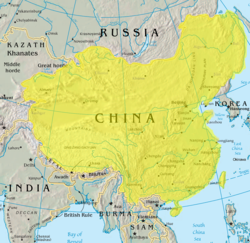Qing government
| Qing dynasty | ||||||||||||||
|
清朝 ᡩᠠᡳᠴᡳᠩ ᡤᡠᡵᡠᠨ |
||||||||||||||
|
||||||||||||||
|
||||||||||||||
|
Anthem 《鞏金甌》 "Gong Jin'ou" ("Cup of Solid Gold") |
||||||||||||||
|
Qing empire, late 18th century
|
||||||||||||||
| Capital | Beijing (Shuntian Prefecture) | |||||||||||||
| Languages | Mandarin, Manchu, Mongolian, Tibetan, Turki (Modern Uighur), numerous regional languages and varieties of Chinese | |||||||||||||
| Religion | Heaven worship, Buddhism, Chinese folk religion, Confucianism, Taoism, Christianity, Islam, Shamanism, others | |||||||||||||
| Government |
Absolute monarchy (1644–1911) Constitutional monarchy (1911–12) |
|||||||||||||
| Emperor | ||||||||||||||
| • | 1644–1661 | Shunzhi (first) | ||||||||||||
| • | 1908–1912 | Puyi (last) | ||||||||||||
| Regent | ||||||||||||||
| • | 1908–12 | Zaifeng | ||||||||||||
| Prime Minister | ||||||||||||||
| • | 1911 | Yikuang | ||||||||||||
| • | 1911–12 | Yuan Shikai | ||||||||||||
| Historical era | Imperial era | |||||||||||||
| • | Qing conquest of the Ming | 1644 | ||||||||||||
| • | First Opium War | 1839–42 | ||||||||||||
| • | Second Opium War | 1856–60 | ||||||||||||
| • | Sino-Japanese War | 1 August 1894 – 17 April 1895 | ||||||||||||
| • | Xinhai Revolution | 10 October 1911 | ||||||||||||
| • | Abdication of Puyi | 12 February 1912 | ||||||||||||
| Area | ||||||||||||||
| • | 1790 | 14,700,000 km² (5,675,702 sq mi) | ||||||||||||
| Population | ||||||||||||||
| • | 1740 est. | 140,000,000 | ||||||||||||
| • | 1776 est. | 268,238,000 | ||||||||||||
| • | 1790 est. | 301,000,000 | ||||||||||||
| Currency |
Cash (wén)
Tael (liǎng) |
|||||||||||||
|
||||||||||||||
| Today part of | ||||||||||||||
| Qing dynasty | |||||||||||||||||||||||||||

"Qing dynasty" in Chinese (top) and Manchu (bottom)
|
|||||||||||||||||||||||||||
| Chinese name | |||||||||||||||||||||||||||
|---|---|---|---|---|---|---|---|---|---|---|---|---|---|---|---|---|---|---|---|---|---|---|---|---|---|---|---|
| Chinese | 清朝 | ||||||||||||||||||||||||||
|
|||||||||||||||||||||||||||
| Great Qing | |||||||||||||||||||||||||||
| Traditional Chinese | |||||||||||||||||||||||||||
| Simplified Chinese | |||||||||||||||||||||||||||
|
|||||||||||||||||||||||||||
| Manchu name | |||||||||||||||||||||||||||
| Manchu script | ᡩᠠᡳᠴᡳᠩ ᡤᡠᡵᡠᠨ |
||||||||||||||||||||||||||
| Abkai | Daiqing gurun | ||||||||||||||||||||||||||
| Möllendorff | Daicing gurun | ||||||||||||||||||||||||||
| Transcriptions | |
|---|---|
| Standard Mandarin | |
| Hanyu Pinyin | Qīng cháo |
| Wade–Giles | Ch'ing1 ch'ao2 |
| IPA | [tɕʰíŋ ʈʂʰǎu̯] |
| Wu | |
| Suzhounese | Tshin záu |
| Yue: Cantonese | |
| Yale Romanization | Chīng chìuh |
| Jyutping | Cing1 ciu4 |
| Southern Min | |
| Hokkien POJ | Chheng tiâu |
| Tâi-lô | Tshing tiâu |
| Transcriptions | |
|---|---|
| Standard Mandarin | |
| Hanyu Pinyin | Dà Qīng |
| Wade–Giles | Ta2 Ch'ing1 |
| Yue: Cantonese | |
| Jyutping | daai6 cing1 |
| Southern Min | |
| Hokkien POJ | Tāi-chheng |
| Tâi-lô | Tāi-tshing |
Tael (liǎng)
The Qing dynasty, officially the Great Qing, also called the Qing Empire or the Manchu dynasty, was the last imperial dynasty of China, ruling from 1644 to 1912 with a brief, abortive restoration in 1917. It was preceded by the Ming dynasty and succeeded by the Republic of China. The Qing multi-cultural empire lasted almost three centuries and formed the territorial base for the modern Chinese state.
The dynasty was founded by the Jurchen Aisin Gioro clan in Manchuria. In the late sixteenth century, Nurhaci, originally a Ming vassal, began organizing "Banners", military-social units that included Jurchen, Han Chinese, and Mongol elements. Nurhaci formed the Jurchen clans into a unified entity, which he renamed as the Manchus. By 1636, his son Hong Taiji began driving Ming forces out of Liaodong and declared a new dynasty, the Qing. In 1644, peasant rebels led by Li Zicheng conquered the Ming capital, Beijing. Rather than serve them, Ming general Wu Sangui made an alliance with the Manchus and opened the Shanhai Pass to the Banner Armies led by the regent Prince Dorgon, who defeated the rebels and seized the capital. Resistance from the Southern Ming and the Revolt of the Three Feudatories led by Wu Sangui extended the conquest of China proper for nearly four decades and was not completed until 1683 under the Kangxi Emperor (r. 1661–1722). The Ten Great Campaigns of the Qianlong Emperor from the 1750s to the 1790s extended Qing control into Central Asia. The early rulers maintained their Manchu ways, and while their title was Emperor, they used khan to the Mongols and they were patrons of Tibetan Buddhism. They governed using Confucian styles and institutions of bureaucratic government and retained the imperial examinations to recruit Han Chinese to work under or in parallel with Manchus. They also adapted the ideals of the tributary system in dealing with neighboring territories.
...
Wikipedia



